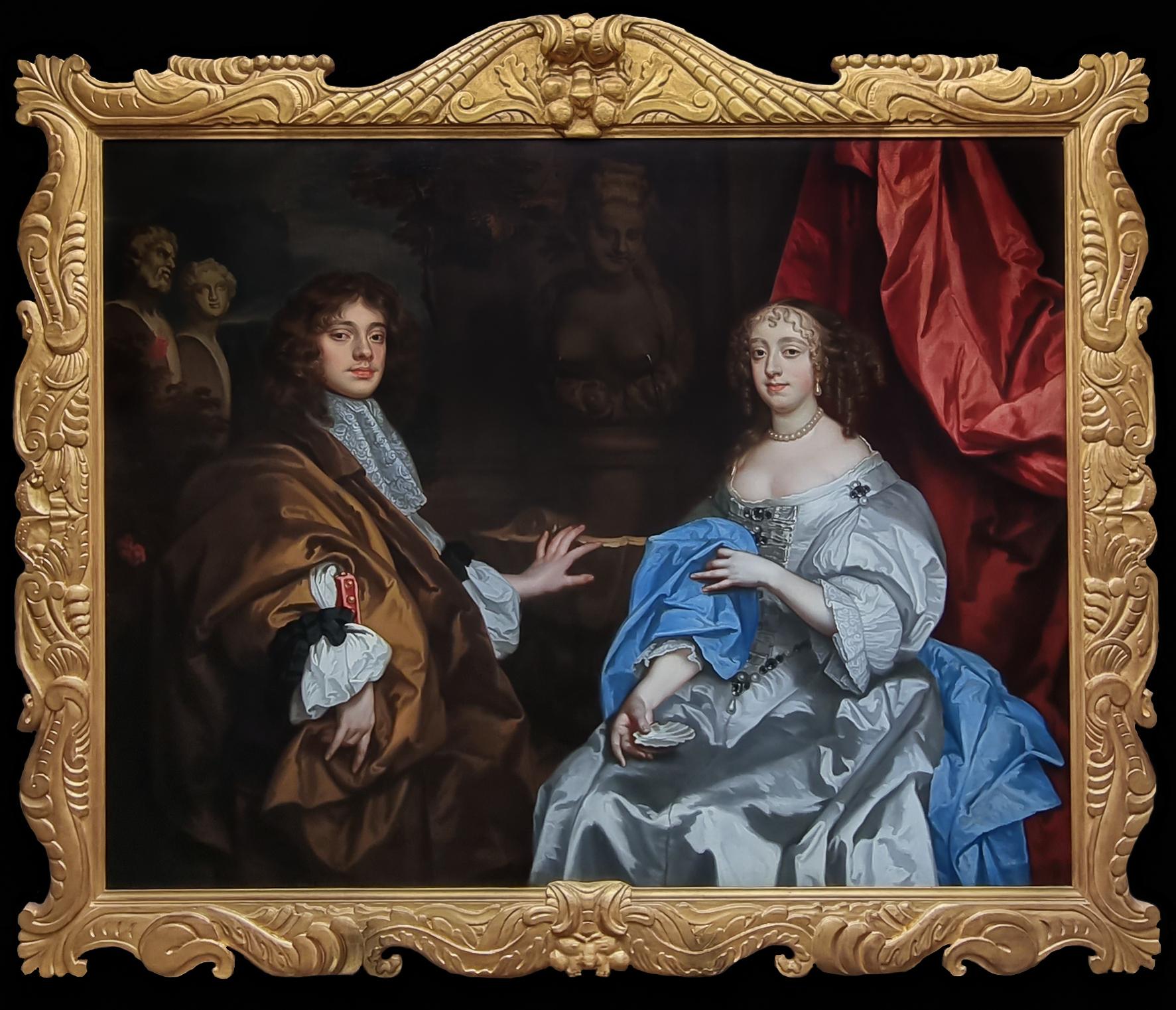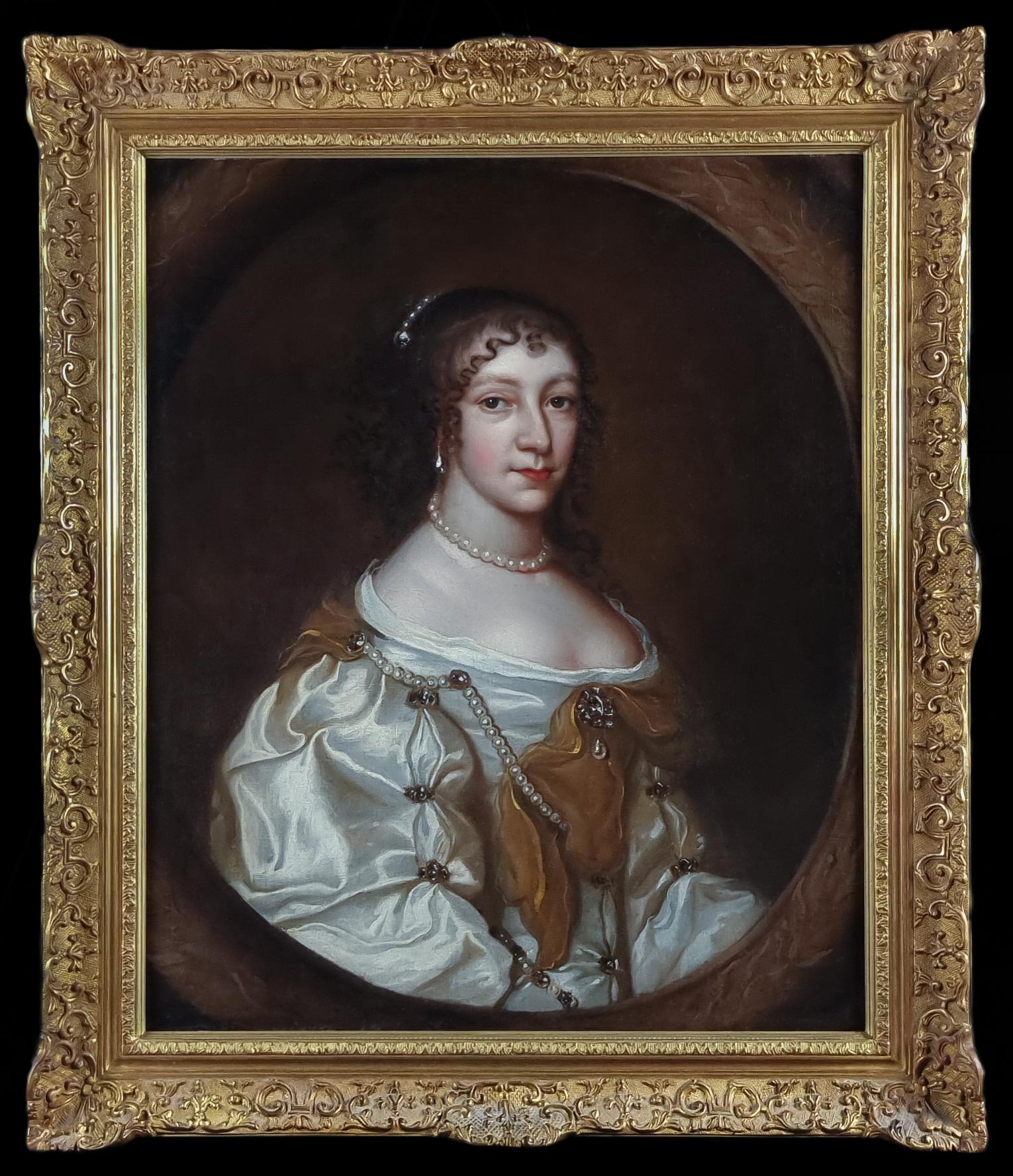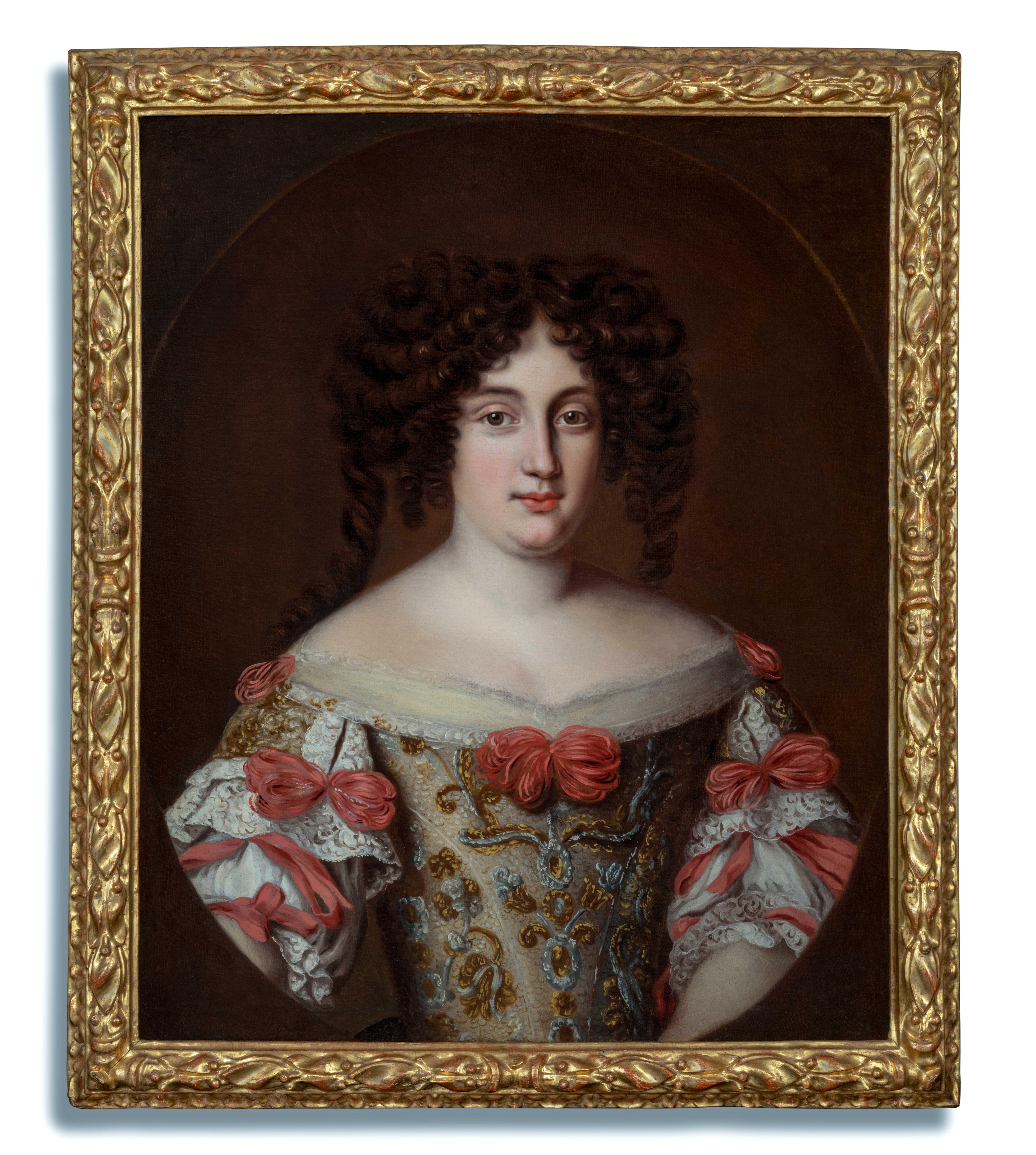Items Similar to Portrait of a Lady with Crimson Wrap & Fur c.1675 Fine Dutch Old Master Painting
Want more images or videos?
Request additional images or videos from the seller
1 of 13
Circle of Gerard SoestPortrait of a Lady with Crimson Wrap & Fur c.1675 Fine Dutch Old Master PaintingCirca 1675-1681
Circa 1675-1681
About the Item
This exquisite portrait, presented by Titan Fine Art, was painted in the era of London’s Great Fire - a young woman has been depicted wearing the most luxurious attire and a fortune in jewellery. The scarlet silk drapery is held in place by two huge gold and pearl brooches. A huge diamond, pearl, and gold brooch is on the bodice, and perhaps most striking of all, is the heavy band of gold, ruby, and pearls prominently displayed over the fur. The huge pear-shaped earrings are called unions d’excellence reflecting the difficulty of finding perfectly matched pearls of such large size (they could range up to 20 millimetres in diameter). The costume and jewellery are of course indicative of this woman’s wealth and this portrait certainly conveys that message. The window, through which the viewer can see a blue sky and a landscape, ads interest to the portrait, and was often used in portraiture at the time.
The artist was immensely adept at the oil technique of painting. The face, hands, and the drapery have been rendered with remarkable delicacy; note the carefully placed highlights to the eyes and the bottom lip. The precise identity of the artist remains elusive however it is clear that they were exceptionally talented. Of the legions of Dutch emigree artists working in England at the time, only a small selection has ever been studied in depth and identified by art experts and historians, leaving the identity of the vast majority unknown to us today, despite some possessing skills on par with the most celebrated artists that we know. This portrait falls into that category… and is a remarkably fine example from the period.
The close-curled hair, springing loosely away from the head, was a fashion of the 1670s and was known as the hurluberlu (first appeared c.1671). This, and the attire, help to date the portrait to circa 1675-1688. In the celebrated letters of Madame de Sévigné when describing the style accounted “Now just imagine the hair parted peasant fashion to within two inches of the back roll; the hair each side is cut in layers and made into round loose curls which hang about an inch below the ear; it looks very young and pretty - two bouquets of hair on each side... a large curl on top which sometimes falls down the neck.” The placement of the delicately rendered hand is reminiscent of the work of Van Dyke.
Upon re-lining this canvas indistinct text (including “King Charles ?”) was uncovered on the reverse (see photo).
Known as Zoust by his contemporaries, Gerard or Gilbert Soest (circa 1600 – 11 February 1681) was a portrait painter who was active in England during the late 17th century. He is most famous for his portraits of William Shakespeare and Samuel Butler, but painted many members of the English gentry.
He was born in Soest, Westphalia, in the early part of the first decade of the seventeenth century, circa 1601/1602 (he was noted by Charles Beale as "neare 80 years old when he died"). Nothing certain is known of his training or of his work in Holland, but his later style suggests links with the Utrecht school.
Soest may have come to London as early as 1644 and was certainly there by 1650. His studio was first near Lincoln's Inn Fields, then in Southampton Buildings, north of the Strand. He was a painter of exceptional distinction and enjoyed good patronage after the Restoration. His work expressed the human, rather than purely social values, of his sitters, and it is these qualities that can be seen in our portrait. His work was chiefly on a head-and-shoulders scale but he also painted in three-quarter-length and full lengths, too. He died in London on 11 February 1681.
Measurements: Height 92cm, Width 78cm framed (Height 36.25”, Width 30.75” framed)
- Creator:Circle of Gerard Soest
- Creation Year:Circa 1675-1681
- Dimensions:Height: 36.23 in (92 cm)Width: 30.71 in (78 cm)Depth: 1.97 in (5 cm)
- Medium:
- Movement & Style:
- Period:
- Condition:The condition is very good and can be hung and enjoyed immediately. The painting has passed a strict condition assessment by a professional conservator prior to going on sale.
- Gallery Location:London, GB
- Reference Number:1stDibs: LU1199113364672
About the Seller
5.0
Platinum Seller
These expertly vetted sellers are 1stDibs' most experienced sellers and are rated highest by our customers.
Established in 1998
1stDibs seller since 2019
31 sales on 1stDibs
Typical response time: <1 hour
- ShippingRetrieving quote...Ships From: London, United Kingdom
- Return PolicyA return for this item may be initiated within 14 days of delivery.
More From This SellerView All
- Portrait of Abigail, Countess of Kinnoull, Signed Dated Godfrey Kneller PaintingBy Kneller GodfreyLocated in London, GBPresented by Titan Fine Art, this elegant and beautiful portrait depicts Abigail Hay, Lady Dupplin, Countess of Kinnoull; it is an excellent example of English portraiture from the f...Category
18th Century Old Masters Portrait Paintings
MaterialsCanvas, Oil
- Double Portrait of Sir John Rivers 3rd Baronet of Chafford, and Lady Anne RiversLocated in London, GBThis magnificent grand-scale work, offered by Titan Fine Art, formed part of a collection of family pictures and heirlooms of the Rivers Baronets and their descendants for over 325 years, before it was dispersed by the last in the line in 1988. The work was painted by the most technically proficient painter in England after the death of Van Dyck, and the dominant court painter to Charles II and James, Duke of York, Sir Peter Lely. It is no surprise that for years Lely had no serious rivals, was enormously influential and successful, and one of the country’s most important painters – and his work influenced countless artists over generations. The exquisite carved and gilded auricular frame is an astounding work of art in itself. The sitters in this exquisite double portrait are Sir John Rivers, who succeeded as the 3rd Baronet Chafford in 1657 (c.1638 - c. 1679), and his wife, Lady Anne Hewitt (c.1640-c.1689). They are seated in an outdoor setting beside a fountain modelled as a female figure with water issuing into a scallop-shell. The water, the elaborate sculpted fountain with its scallop-edged bowl, and the open shell in her hand are symbols of fertility - as such they make an appropriate allusion to Lady Anne’s potential as wife and mother, recalling Proverbs, chapter 5, verse 18: “Let thye fountain be blessed, and rejoice in the wife of thye youth”. This reference was realised, as Sir John and Lady Anne produced at least six children; their son George (1665-1734) became 4th Baronet of Chafford. The composition, thus, represents a celebration of marriage and was likely commissioned around the time of the betrothal (the marriage took place 26th Feb 1662 or 1663). The statues in the left margin are 'Youth and 'Old Age' and are a typical form of Memento Mori reminding virile young man that even they will lose their youth and grow old. The Rivers family, originally of Kent, traces its history to Sir Bartholomew Rivers, in the reign of Edward IV. The family included several prominent members including several knights, a Commander in the King's Army, a steward of a ducal estate, a Lord-Mayor of London, and an M.P. John Rivers (c.1659-c.1651) was made 1st Baronet of Chafford in 1622 by King James I. The Chafford estate was the family seat and it remained so until the early 1700s with the death of Sir George Rivers, 4th Baronet (1665–1734), whose sons had all died. The Chafford estate was left to his daughters while the baronetcy passed to nephew John Rivers, 5th Baronet (c. 1718–1743), and then Sir John’s brother, Sir Peter Rivers-Gay, 6th Baronet (c. 1721–1790). Upon Sir Peter Rivers Gay's death the estate passed to his eldest son, Sir Thomas Rivers Gay, 7th Baronet (c. 1770–1805). Sir Thomas, dying in 1805 with no children, bequeathed the estate to his mother Dame Martha Rivers Gay, who managed the estate until 1834 when she settled it on the then Sir Henry Rivers, 9th Baronet (c. 1779–1851) her younger son, before dying shortly thereafter in 1835. Sir Henry had married in 1812 to Charlotte Eales, with whom he had 6 sons and 8 daughters. Upon his death in 1851 the estate passed to his eldest surviving son Sir James Francis Rivers, 10th Baronet (1822–1869). Sir James married Catherine Eastcott in 1867 but died childless in 1869, and the estate passed to his only surviving brother Sir Henry Chandos Rivers, 11th Baronet (1834–1870) but he died a year later in 1870 also childless; with no male heir the Baronetcy was therefore extinguished. The estate was bequeathed, in trust, by Sir Henry Chandos Rivers to Thomas Frederick Inman, a solicitor of Bath, who then managed the estate as a trustee on behalf of Sir Henry Chandos Rivers' sister Katherine Rivers (c.1826-1895). It then passed to Katherine River’s daughter, Katherine Wall (born c.1855), who had also inherited Worthy Park House from her father, George Alfred Ellis Wall (1825-1875). Until 1958 our portrait is known to have hung at Worthy Park House. Upon Katherine Wall’s death, the Rivers estate passed to her daughter, Katherine Eleonora Rivers Fryer (1889-1963), who married Colonel James Alexander Butchart 1877-1853. In 1958 the family sold Worthy Park House but our portrait was loaned to Southampton Museum and Art Gallery. After the death of Katherine and Colonel James, the estate was left to their only son, Charles Bruce Rivers Butchart (1917-2005) and upon Charles’ retirement to a nursing home in 1988, and without heirs, our portrait, along with the residual assets of the Rivers estate were sold, thus ending over 325 years of continual family ownership. Lady Anne Rivers is thought to have been born circa 1640. She was the fourth child of the second marriage of Sir Thomas Hewitt (or Hewett) (1606-1662), 1st Baronet of Pishobury, Herts, and his wife Margaret Lytton (died 1689). Sir Thomas was an English landowner and M.P. for Windsor and upon the English Restoration...Category
17th Century Old Masters Portrait Paintings
MaterialsCanvas, Oil
- Portrait of a Lady in Silver Silk Dress & Pearls c.1660, Oil on canvas paintingLocated in London, GBThis exquisite work is an accomplished example of the type of portrait in vogue in England during the third quarter of the 17th century. There was a large demand for paintings in England and the demand for portraits was greatest. Many artists worked in this lucrative field, even artists who initially trained in the more respected field of history painting, such as Peter Lely, turned their attention to portraiture to meet this demand. Moreover, it was not uncommon for the British, even for men, to present a gift of one’s portrait to a friend - portraits were first and foremost a memento. Woman at court often vied with one another in displays of rich and fashionable clothing. The drapery was either painted from the customer’s own clothes or was perhaps a creation using fabrics loosely tacked together in the studio. This was a common practice of Lely and his studio props included swathes of fabric and pieces of cloth. The sitter’s sumptuous attire and gauze scarf, fastened by a large diamond brooch, is of the finest material and is representative of wealth. Pearls were an obligatory accompaniment since at least the 1630s and they are worn in abundance – in her hair, on her attire, as a necklace, and as pear-shaped earrings called unions d’excellence, reflecting the difficulty of finding perfectly matched pearls of such large size. They could range up to 20 millimetres in diameter. Her hairstyle help date the painting to the early 1660’s. Peter Lely, the son of a Dutch...Category
17th Century Old Masters Portrait Paintings
MaterialsCanvas, Oil
- Portrait of a Lady, Maria Virginia Borghese Chigi Princess Farnese Oil on canvasLocated in London, GBThis exquisite portrait, presented by Titan Fine Art, belongs to a type of portrait known as ‘Les Belle Romanes’; Voet is perhaps best remembered for his series of them – a great set of portraits...Category
17th Century Old Masters Portrait Paintings
MaterialsCanvas, Oil
- Portrait Lady in Red Silk Dress c.1710, Michael Dahl, oil on canvas paintingBy (Circle of) Michael DahlLocated in London, GBThis charming work is a good example of the type of portrait in vogue during the first quarter of the eighteenth century in Britain. The sitter, portrayed bust-length, wears a russet silk dress over a white chemise...Category
18th Century Old Masters Portrait Paintings
MaterialsCanvas, Oil
- Portrait of a Lady, Katherine St Aubyn, Godolphin, Cornelius Johnson, Oil canvasBy Cornelius JohnsonLocated in London, GBTitan Fine Art are pleased to present this charming bust-length portrait, which is a good example of the style of portrait painted in England in the second quarter of the seventeenth century. The attire consists of the finest silks, and the full billowing sleeves, bows, and hairstyle help in dating this portrait to circa 1637. The accessory par excellence – pearls – are worn as a necklace and were a very popular accessory. The artist makes no attempt to obey the rules of Baroque and instead sensitively depicts in complete honesty his sitter against a plain wall, and without distracting backdrops and flowing draperies – this work is very redolent of the sumptuous half-length female portraits that Cornelius Johnson...Category
17th Century Old Masters Portrait Paintings
MaterialsCanvas, Cotton Canvas, Oil
You May Also Like
- Attributed to John Riley, 17th century English portrait of a girl on a terraceBy John RileyLocated in Bath, SomersetPortrait of a young girl, full-length, wearing a blue silk gown, standing on a terrace beside a classical urn holding a branch with blossom. Attributed to John Riley...Category
17th Century Old Masters Portrait Paintings
MaterialsOil, Canvas
- Large 1700's Italian Oil Painting on Canvas Portrait of a Clerical GentlemanLocated in Cirencester, GloucestershirePortrait of a Clerical Gentleman Italian artist, mid 18th century Circle of Giovanni Battista Carboni (1725-1790) oil on canvas, unframed canvas: 26 x 22 inches provenance: private c...Category
Mid-18th Century Old Masters Portrait Paintings
MaterialsOil, Canvas
- Huge 18th Century English Oil Aristocratic Portrait of a Gentleman StandingLocated in Cirencester, GloucestershirePortrait of an Aristocratic Gentleman British artist, first half 18th century oil on canvas, unframed canvas: 50 x 40 inches provenance: private collection, Dorset, England condition...Category
18th Century Old Masters Portrait Paintings
MaterialsOil, Canvas
- 18th Century European Portrait of a Child Saint John the BaptistLocated in SANTA FE, NM18th Century European Portrait of a Child Saint John the Baptist Oil on Canvas 19 x 14 1/4 inches This lovely and sensitively painting has been examined by a professional restorer w...Category
18th Century Old Masters Figurative Paintings
MaterialsOil, Canvas
- 19th century English portrait of a White/grey hunter in a stableBy Charles TowneLocated in Woodbury, CTEnglish 19th century portrait of a White / Grey hunter in a stable. Charles Towne was born in Wigan in 1763. He was trained as a coach painter, and by ...Category
1820s Old Masters Animal Paintings
MaterialsOil, Canvas
- 18th Century portrait oil painting of a girl with an orangeBy Robert ByngLocated in Nr Broadway, WorcestershireCircle of Robert Byng British, (1666-1720) Girl with Orange Oil on canvas Image size: 29 inches x 24 inches Size including frame: 36 inches x 31 inc...Category
18th Century Old Masters Portrait Paintings
MaterialsCanvas, Oil





